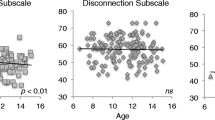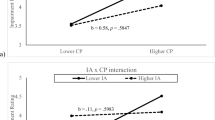Abstract
The present investigation addressed the utility of the revised Conners' Teachers Rating Scale (CTRS-28) with low-income urban preschool children. CTRS-28 ratings for a large sample of preschool children from an urban Head Start program were analyzed using exploratory factor analysis. Analyses yielded a 3-factor structure: Conduct problems, Hyperactivity, and Passivity. Further analyses cross-validated this structure for males and females and supported its integrity. Multimethod, multisource validity analyses substantiated the CTRS-28 dimensions. The Play Disruption factor of the parent and teacher Penn Interactive Peer Play Scales (PIPPS) provided convergent validity for the Conduct and Hyperactivity factors of the CTRS-28, whereas the Play Interaction factor revealed divergent validity. The Play Disconnection factor of the PIPPS validated the CTRS-28 Passivity factor. The Q-Sort Emotional Regulation scale provided divergent validity for the Conduct and Hyperactivity factors and likewise the Q-Sort Autonomy scale provided divergent validity for the Passivity factor. Age and sex differences were assessed across the 3 factors of the derived preschool structure. A main effect was found for sex and age indicating that boys displayed higher levels of Hyperactivity and Passivity problems than girls did. Similarly, 4-year-old children demonstrated higher levels of Passivity problems than did 5-year-old children.
Similar content being viewed by others
REFERENCES
Achenbach, T. M., Edelbrock, C., & Howell, C. T. (1987). Empirically based assessment of the behavioral/emotional problems of 2–and 3–year-old children. Journal of Abnormal Child Psychology, 15, 629–650.
American Psychological Association. (1992). Ethical principles of psychologists and code of conduct. American Psychologist, 47, 1597–1611.
Anderberg, M. R. (1973). Cluster analysis for applications. New York: Academic Press.
Block, J. H., & Block, J. (1980). The role of ego-control and egoresiliency in the organization of behavior. In Collins W. A., (Ed.), Development of cognition, affect, and social relations: The Minnesota Symposia on Child Psychology (Vol. 13, pp. 39–101). Hillsdale, NJ: Lawrence Erlbaum.
Brandenburg, N. A., Friedman, R. M., & Silver, S. E. (1990). The epidemiology of childhood psychiatric disorders: Prevalence findings from recent studies. Journal of the American Academy of Child and Adolescent Psychiatry, 29, 76–83.
Campbell, S. B. (1997). Behavior problems in preschool children: Developmental and family issues. Advances in Clinical Child Psychology, 19, 1–26.
Campbell, S. B., & Breaux, A. M. (1983). Maternal ratings of activity level and symptomatic behavior in a non-clinical sample of young children. Journal of Pediatric Psychology, 8, 73–82.
Cicchetti, D., & Lynch, M. (1993). Toward an ecological/transactional model of community violence and child maltreatment: Consequences for children's development. Psychiatry, 56, 96–118.
Cicchetti, D., & Richters, J. E. (1993). Developmental considerations in the investigation of conduct disorder. Development and Psychopathology, 5, 331–344.
Coie, J. D., Dodge, K. A., & Kupersmidt, J. B. (1990). Peer groups behavior and social status. In Aster S. R., & Coie J. D., (Eds.), Peer rejection in childhood (pp. 17–59). Cambridge, England: Cambridge University Press.
Coll, C. G., Lamberty, G., Jenkins, R., McAdoo, H., Crnic, K., Wasik, B., & Vazquez Garcia, H. (1996). An integrative model for the study of developmental competencies in minority children. Child Development, 67, 1891–1914.
Conners, C. K. (1990). Conners' Rating Scales Manual. New York: Multi-Health Systems, Inc.
Coolahan, K. C. (1997). Empirical relationships among parenting styles, determinants of parenting, and children's school readiness in urban Head Start families. Unpublished doctoral dissertation, University of Pennsylvania.
Coolahan, C., Fantuzzo, J., Mendez, J., & McDermott, P. (in press). Interactive peer play and readiness to learn: relationships between play competencies and classroom learning behaviors and conduct. Journal of Educational Psychology.
Dodge, K. A., Pettit, G. S., & Bates, J. E. (1994). Socialization mediators of the relation between socioeconomic status and child conduct problems. Child Development, 65, 649–665.
Fantuzzo, J., Coolahan, K. C., Mendez, J. L., McDermott, P. A., & Sutton-Smith, B. (1998). Contextually-relevant validation of constructs of peer play with African American Head Start children: Penn Interactive Peer Play Scale. Early Childhood Research Quarterly, 13(3), 411–431.
Fantuzzo, J., & Hampton, V. (in press). Penn Interactive Peer Play Scale: A Parent and teacher rating system for young children. In Gitlin-Weiner K., Sandgrund A., & Schaefer C. (Eds.), Play diagnosis and assessment. New York: Wiley.
Fantuzzo, J. W., McDermott, P., Manz, P. H., Hampton, V., & Burdick, N. (1996). The Pictorial Scale of Perceived Competence for Young Children: Does it work with low-income urban children? Child Development, 67, 1071–1084.
Fantuzzo, J., Mendez, J., & Tighe, E. (1998). Parental assessment of peer play: Developmental and validation of the parent version of the Penn Interactive Peer Play Scale. Early Childhood Research Quarterly, 13(4), 655–672.
Fantuzzo, J., Stoltzfus, J., Noone, M., Buchanan, H., Balraj, V., Turner, C., & Mosca, S. (in press). An empirical assessment of the special needs referral process in Head Start for children with emotional and behavioral problems. Early Childhood Research Quarterly.
Fergusson, D. M., Horwood, L. J., & Lawton, J. M. (1990). Vulnerability to childhood problems and family social background. Journal of Child Psychology and Psychiatry and Allied Disciplines, 31, 1145–1160.
Gorsuch, R. L. (1983). Factor Analysis (2nd ed.). Hillsdale, NJ: Erlbaum.
Goyette, C. H., Conners, C. K., & Ulrich, R. F. (1978). Normative data on revised Conners Parent and Teacher Rating Scales. Journal of Abnormal Child Psychology, 6, 221–236.
Guadagnoli, E., & Velicer, W. (1991). A comparison of pattern matching indices. Multivariate Behavioral Research, 23(2), 323–343.
Guilford, J. P. (1956). Psychometric methods. New York: McGraw-Hill.
Guralnick, M. J. (1993). Developmentally appropriate practice in the assessment and intervention of children's peer relations. Topic in Early Childhood Special Education, 13, 344–371.
Hart, C. W., DeWolf, D. M., Wozniak, P., & Burts, D. C. (1992). Maternal and paternal disciplinary styles: Rations with preschoolers' playground behavioral orientations and peer status. Child Development, 63, 879–892.
Hart, C. H., Olsen, S. F., Robinson, C. C., & Mandleco, B. L. (1997). The development of social and communicative competence in childhood: Review and a model of personal, familial, and extrafamilial processes. Communication Yearbook, 20, 305–373.
Individuals with Disabilities Education Act Amendments (IDEA) of 1997, 20 U.S.C. § 1400 et seq.
Kagen, S. L., Moore, E., & Bredekamp, S. (Eds.). (1995). Reconsidering children's early development and learning: Toward common views and vocabulary. Washington, DC: National Education Goals Panel.
Kline, P. (1993). The handbook of psychological testing. New York: Routledge.
LaFreniere, P. J., & Dumas, J. E. (1996). Social competence and behavior evaluation in children ages 3 to 6 years: The short form (SCBE-30). Psychological Assessment, 8(4), 369–377.
Lavigne, J. V., Gibbons, R. D., Christoffel, K. K., Arend, R., Rosenbaum, D., Binns, H., Dawson, N., Sobel, H., & Isaacs, C. (1996). Prevalence rates and correlates of psychiatric disorders among preschool children. Journal of the American Academy of Child and Adolescent Psychiatry, 35, 204–214.
Lutz, M. N. (1999). Contextually relevant assessment of the emotional and behavioral adjustment of Head Start children. Unpublished doctoral dissertation, University of Pennsylvania.
Mallory, B. L., & Kerns, G. M. (1988). Consequences of categorical labeling of preschool children. Topics in Early Childhood Special Education, 8, 39–50.
McLoyd, V. S. (1985). Are toys (just) toys? Exploring their effects on pretend play of low-income preschoolers. In Spencer M. B., Brookins G. K., & Allen W. R., (Eds.), Beginnings: The social and affective development of black children (pp. 201–214). Hillsdale, NJ: Erlbaum.
McLoyd, V. C. (1998). Socioeconomic disadvantage and child development. American Psychologist, 53(2), 185–204.
Mendez, J. L. (1999). Empirical relationships between developmental competencies and peer play behaviors with African American Head Start children. Unpublished doctoral dissertation, University of Pennsylvania.
Miller, L. S., Koplewicz, H. S., & Klein, R. G. (1997). Teacher ratings of hyperactivity, inattention, and conduct problems in preschoolers. Journal of Abnormal Child Psychology, 25, 113–119.
Nunnally, J. C. (1978). Psychometric theory (2nd ed.). New York: McGraw-Hill.
Patterson, C. J., Kupersmidt, J. B., & Vaden, N. A. (1990). Income level, gender, ethnicity, and household composition as predictors of children's school-based competence. Child Development, 61, 485–494.
Pianta, R. C., & Caldwell, C. B. (1990). Stability of externalizing symptoms from kindergarten to first grade and factors related to instability. Development and Psychopathology, 2, 247–258.
Piotrowski, C. S., Collins, R. C., Knitzer, J., & Robinson, R. (1994). Strengthening mental health services in Head Start. American Psychologist, 49, 133–139.
Prior, M., Smart, D., Sanson, A., & Oberklaid, F. (1993). Sex differences in psychological adjustment from infancy to 8 years. Journal of the American Academy of Child and Adolescent Psychiatry, 32, 291–304.
Rogers, M. (1998). Psychoeducational assessment of culturally and linguistically diverse children and youth. In Vance H., (Ed.), Psychological assessment of children (pp. 355–384). New York: John Wiley & Sons.
Rose, S. L., Rose, S. A., & Feldman, J. F. (1989). Stability of behavior problems in very young children. Development and Psychopathology, 1, 5–19.
Shields, A. M., & Cicchetti, D. (1997). Emotion regulation and autonomy: The development and validation of two new criterion Q-sort scales. Developmental Psychology, 33(6), 906–916.
Snook, S. C., & Gorsuch, R. L. (1989). Component analysis versus common factor analysis: A Monte Carlo study. Psychological Bulletin, 106, 148–154.
Sroufe, L. A. (1996). Emotional development: The organization of emotional life in the early years. New York: Cambridge.
Spencer, M. B. (1999). Social and cultural influences on school adjustment: The application of an identity-focused cultural ecological perspective. Wentzel In K., & Berndt T. (Eds.) [Special Issue]. Educational Psychologist, 34(1), 43–57.
Takanishi, R., & DeLeon, P. H. (1994). A Head Start for the 21st century. American Psychologist, 49(2), 120–122.
Weinberger, L. A., & Starkey, P. (1994). Pretend play by African American children in Head Start. Early Childhood Research Quarterly, 9, 327–343.
Weiss, D. J. (1972). Canonical correlation analysis in counseling psychology research. Journal of Counseling Psychology, 19(3), 241–252.
Wood, J. M., Tataryn, D. J., & Gorsuch, R. L. (1996). Effects of under-and overextraction on principal axis factor analysis with varimax rotation. Psychological methods, 1, 354–365.
Author information
Authors and Affiliations
Rights and permissions
About this article
Cite this article
Fantuzzo, J., Grim, S., Mordell, M. et al. A Multivariate Analysis of the Revised Conners' Teacher Rating Scale with Low-Income, Urban Preschool Children. J Abnorm Child Psychol 29, 141–152 (2001). https://doi.org/10.1023/A:1005236113655
Issue Date:
DOI: https://doi.org/10.1023/A:1005236113655




